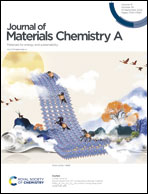Rationally regulating the π-bridge of small molecule acceptors for efficient organic solar cells†
Abstract
Nonfullerene acceptors have boosted the power conversion efficiencies (PCE) of organic solar cells (OSCs). Rigid fused-ring molecular skeletons enable decent molecular planarity and stacking orientations, but suffer from tedious synthesis procedures for those with large π-backbones. Promisingly, the π-bridge strategy provides an alternative to readily manipulate the light utilization, but sometimes increases the conformation complexity. To rationally regulate the performance of π-bridged acceptors, herein, we report two new acceptors WA1 and WA2, functionalized with single or dual π-bridges flanking the phenylalkyl modified indacenodithiophene (IDT) backbone. The unilateral π-bridge endows WA1 with an asymmetric electron cloud distribution, affording a greater dipole moment and well-organized molecular orientation. In contrast, the bilateral π-bridges endow WA2 with two disparate molecular dipoles and disordered stacking orientations, generating inferior PCEs below 10%. Notably, the PM6:WA1 device shows a remarkable PCE of up to 15.45% with an impressive fill factor (FF) of up to 79.31%, both of which rank among the highest values of OSCs with π-bridged acceptors. More importantly, the PM6:Y6:WA1 ternary organic solar cell (TOSC) affords a high PCE of up to 18.15%, which is the best efficiency among Y6-based bulk-heterojunction TOSCs and the first example of an efficient ternary cell featuring a π-bridged guest acceptor.



 Please wait while we load your content...
Please wait while we load your content...